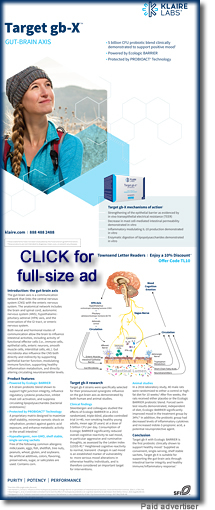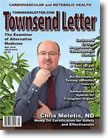|
Strontium is a mineral that is present in small quantities in food and water (a few milligrams per day), as well as in the human body (primarily in bone and connective tissue). Strontium is incorporated in small amounts into the hydroxyapatite crystal lattice of bone, where it remains bound for years or decades and may improve bone quality.1 When administered in pharmacological doses, strontium stimulates bone formation, inhibits bone resorption, and increases bone mineral density.
 In several double-blind trials, treatment with strontium in doses of 170-680 mg per day (as strontium ranelate) for two to five years significantly increased bone mineral density of the hip and spine and significantly reduced the incidence of fractures by 16-49%, compared with placebo, in postmenopausal women with osteoporosis.2-5 Because of these studies, high-dose strontium became popular for the prevention and treatment of osteoporosis. However, concern has been raised in recent years that the risks of high-dose strontium may be at least as great as the benefits. The doses of strontium used in clinical trials are in the range of 60-200 times the amount present in a typical diet. For perspective, long-term administration of other trace minerals (such as zinc, copper, or selenium) in amounts 60-200 times greater than typical dietary intake has been reported to cause serious adverse effects. In several double-blind trials, treatment with strontium in doses of 170-680 mg per day (as strontium ranelate) for two to five years significantly increased bone mineral density of the hip and spine and significantly reduced the incidence of fractures by 16-49%, compared with placebo, in postmenopausal women with osteoporosis.2-5 Because of these studies, high-dose strontium became popular for the prevention and treatment of osteoporosis. However, concern has been raised in recent years that the risks of high-dose strontium may be at least as great as the benefits. The doses of strontium used in clinical trials are in the range of 60-200 times the amount present in a typical diet. For perspective, long-term administration of other trace minerals (such as zinc, copper, or selenium) in amounts 60-200 times greater than typical dietary intake has been reported to cause serious adverse effects.
Several years ago, the European Medicines Agency's Pharmacovigilance Risk Assessment Committee reviewed randomized controlled trials of strontium ranelate and concluded that it increases the risk of cardiovascular disease. A review of seven trials and five publicly available regulatory documents concluded that the number of fractures prevented by strontium ranelate was similar to the number of extra cases of venous thromboembolism, pulmonary embolism, and myocardial infarction caused by this compound.6 Strontium ranelate is therefore contraindicated in patients with cardiovascular disease (i.e., ischemic heart disease, peripheral artery disease, and/or cerebrovascular disease) and in those with uncontrolled hypertension.7 In addition, at least 47 cases of drug-induced hypersensitivity syndrome (DRESS syndrome), one of which was fatal, have been reported in patients taking strontium ranelate.8 Other side effects of strontium ranelate include transient increases in creatine kinase levels and mild gastrointestinal, nervous system, and muscular disorders. Because of these adverse effects, the European Medicines Agency recommended that strontium ranelate be used only by patients who cannot be treated with other medicines approved for osteoporosis.
In August 2017, Servier (the manufacturer of strontium ranelate) withdrew this compound from the market worldwide.9 The company stated that the decision to withdraw strontium ranelate was not related to a safety issue but, rather, to restricted indications and limitations on its use. Of course, those restrictions and limitations were imposed as a direct result of safety concerns.
Strontium ranelate was licensed as a prescription medicine in Europe, but it was never approved by the Food and Drug Administration for use in the United States. Other forms of strontium (mainly strontium citrate) have been available without a prescription in the US for the past decade or so. It is not known whether the reported adverse effects of strontium ranelate would also occur with other forms of strontium. While there have been no reports of DRESS syndrome or of an increased risk of cardiovascular disease in people taking non-ranelate forms of strontium, there have been no systematic toxicity studies of these compounds in humans. In rats, administration of strontium chloride resulted in an increase in thyroid weight and a decrease in pituitary weight. The "no-observed-adverse-effect level" in the rat studies was roughly equivalent to 41 mg of strontium per day for humans,10 which means that strontium had potentially deleterious effects on the endocrine system at dosages well below those used in clinical trials.
 In the absence of systematic toxicity studies, it is difficult to determine the risk-benefit ratio for non-ranelate forms of strontium. High-dose strontium probably should not be given to patients who have or are at high risk of developing cardiovascular disease; and patients being treated with high-dose strontium should be monitored for the development of heart disease and thromboembolism. In the absence of systematic toxicity studies, it is difficult to determine the risk-benefit ratio for non-ranelate forms of strontium. High-dose strontium probably should not be given to patients who have or are at high risk of developing cardiovascular disease; and patients being treated with high-dose strontium should be monitored for the development of heart disease and thromboembolism.
Researchers should investigate the possibility that the beneficial effects of high-dose strontium could be duplicated at least in part by much lower "nutritional" doses, such as 2-6 mg per day. The improvement in bone quality that results from the incorporation of strontium into hydroxyapatite crystals likely occurs with small doses of strontium, since strontium is present in the hydroxyapatite crystals of people who do not take strontium supplements. The possibility that low-dose strontium is beneficial is supported by the results of one study, in which the reduction in fracture incidence was nonsignificantly greater with 170 mg per day of strontium than with 340 or 680 mg per day.5 Whether doses less than 170 mg per day would influence bone mineral density or fracture risk has not been investigated.
References
1. Schroeder HA, et al. Trace metals in man: strontium and barium. J Chronic Dis. 1972;25:491-517.
2. Meunier PJ, et al. The effects of strontium ranelate on the risk of vertebral fracture in women with postmenopausal osteoporosis. N Engl J Med. 2004;350:459-468.
3. Reginster JY, et al. Strontium ranelate reduces the risk of nonvertebral fractures in postmenopausal women with osteoporosis: Treatment of Peripheral Osteoporosis (TROPOS) study. J Clin Endocrinol Metab. 2005;90:2816-2822.
4. Reginster JY, et al. Effects of long-term strontium ranelate treatment on the risk of nonvertebral and vertebral fractures in postmenopausal osteoporosis. Results of a five-year, randomized, placebo-controlled trial. Arthritis Rheum. 2008;58:1687-1695.
5. Meunier PJ, et al. Strontium ranelate: dose-dependent effects in established postmenopausal vertebral osteoporosis - a 2-year randomized placebo controlled trial. J Clin Endocrinol Metab. 2002;87:2060-2066.
6. Bolland MJ, Grey A. A comparison of adverse event and fracture efficacy data for strontium ranelate in regulatory documents and the publication record. BMJ Open. 2014;4:e005787.
7. Donneau AF, Reginster JY. Cardiovascular safety of strontium ranelate: real-life assessment in clinical practice. Osteoporos Int. 2014;25:397-398.
8. Cacoub P, et al. Drug rash with eosinophilia and systemic symptoms (DRESS) in patients receiving strontium ranelate. Osteoporos Int. 2013;24:1751-1757.
9. Bolland MJ, Grey A. Cessation of strontium ranelate supply. BMJ. 2017;357:j2580.
10. Kroes R, et al. Short-term toxicity of strontium chloride in rats. Toxicology. 1977;7:11-21. Note: This estimate was based on a human diet providing 2,000 kcal/day, with 30% of energy from fat (i.e., 417 g/day of food, dry weight.


|
|
![]()
![]()
![]()
![]()







